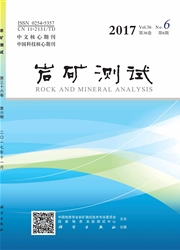

 中文摘要:
中文摘要:
马坑铁(钼)矿是一个赋存于莒舟一大洋花岗岩外接触带黄龙组(C2h)灰岩和林地组(C1ι)碎屑岩层间构造破碎带中的大型铁矿床。本文利用电感耦合等离子体质谱法(ICP—MS)对马坑的石榴子石、辉石、黄铁矿和磁铁矿矿石的稀土元素(REEs)开展研究。结果表明:石榴子石、辉石和磁铁矿单矿物的稀土分配模式具有相似性,多为轻稀土富集,正铕异常,基本无铈异常,表明其成矿环境为氧化环境,暗示它们之间存在成因联系。矿体附近大理岩和退化蚀变岩稀土元素特征出现规律性变化,表明它们受到岩浆期后热液的交代作用的影响.碎屑岩和褪色辉绿岩提供了部分铁质。
 英文摘要:
英文摘要:
The Makeng Fe-Mo deposit is a large skarn-type magnetite deposit hosted by interbedded structural fracture zone between limestone in the Huanglong formation (C2h) and clastic rocks in the Lindi formation (Clι) in the vicinity of the outer aureole of the Juzhou-Dayang granite intrusion. The rare earth elements ( REEs ) in garnet, pyroxene, pyrite and magnetite from the Makeng deposit were studied by Inductively Coupled Plasma-Mass Spectrometry (ICP-MS). The results demonstrate that garnet, pyroxene, pyrite and magnetite have similar chondrite-normalized REEs distribution patterns with light REEs (LREEs) enrichment, moderate Eu positive anomaly and no Ce anomaly. It implies a genetic relation between ores and skarns, which were formed in an oxidation environment. The REEs characteristics of nearby marble and altered rocks varied regularly, which indicates that they were influenced by the metasomatism of post-magmatic hydrothermal fluids, and the ore-forming materials were partially derived from surrounding clastic rocks and diabase.
 同期刊论文项目
同期刊论文项目
 同项目期刊论文
同项目期刊论文
 Petrogenesis of the Xihuashan granites in southeastern China: Constraints from geochemistry and in-s
Petrogenesis of the Xihuashan granites in southeastern China: Constraints from geochemistry and in-s Ages and geochemistry of Laojunshan granites in southeastern Yunnan, China: implications for W-Sn po
Ages and geochemistry of Laojunshan granites in southeastern Yunnan, China: implications for W-Sn po SHRIMP U-Pb (zircon), Ar-Ar (muscovite) and Re-Os (molybdenite) isotopic dating of the Taoxikeng tun
SHRIMP U-Pb (zircon), Ar-Ar (muscovite) and Re-Os (molybdenite) isotopic dating of the Taoxikeng tun Age and Geochemistry of Granites in Gejiu area, Yunnan province, SW China: Constraints on their petr
Age and Geochemistry of Granites in Gejiu area, Yunnan province, SW China: Constraints on their petr Petrogenesis and geodynamic implications of Gejiu igneous complex in the western Cathaysia block, So
Petrogenesis and geodynamic implications of Gejiu igneous complex in the western Cathaysia block, So Timing of the formation of the Tianhuashan Basin in northern Wuyi as constrained by geochronology of
Timing of the formation of the Tianhuashan Basin in northern Wuyi as constrained by geochronology of Granite, gabbro and mafic microgranular enclaves in the Gejiu area, Yunnan Province, China: a case o
Granite, gabbro and mafic microgranular enclaves in the Gejiu area, Yunnan Province, China: a case o 期刊信息
期刊信息
